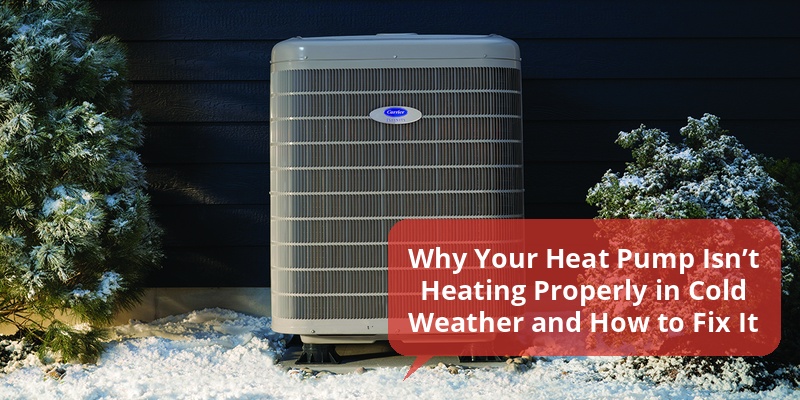Heat pumps are popular for their energy efficiency and ability to both heat and cool homes. However, when temperatures drop, many homeowners face the frustrating issue of their heat pump not heating in cold weather. Understanding why this happens and how to address it can help maintain a warm and comfortable home during winter months.
| Common Causes | Resulting Issue | Recommended Action |
|---|---|---|
| Frost or Ice Build-up on Outdoor Unit | Reduced heat transfer efficiency | Activate defrost mode, clean unit |
| Low Refrigerant Levels | Decreased heating capacity | Professional refrigerant recharge |
| Faulty Thermostat or Sensors | Improper heat pump operation | Thermostat replacement or recalibration |
| Incorrect Heat Pump Size or Installation | Inadequate heating during extreme cold | System evaluation and possible upgrade |
| Electrical Issues | Frequent system shutdowns or poor performance | Electrical system diagnostics and repair |
How Heat Pumps Work in Cold Weather
Heat pumps operate by extracting heat from the outside air and transferring it indoors, even at low temperatures. They use a refrigeration cycle, involving a compressor and refrigerant, to move heat from the external environment to heat a home. However, when outdoor temperatures fall significantly below freezing, the heat pump’s efficiency and ability to extract heat can diminish.
Many models include a defrost cycle that prevents ice accumulation on the outdoor coil, which can hinder heat transfer. Despite this, in very cold conditions, a heat pump may struggle to maintain sufficient indoor temperatures without supplemental heating.
Reasons Heat Pumps Fail to Heat During Cold Weather
Several factors can cause your heat pump to stop heating effectively when temperatures drop:
1. Frost and Ice Build-up on the Outdoor Unit
In cold, humid weather, moisture can freeze on the outdoor coil, limiting airflow and heat transfer. While defrost cycles help, malfunction or improper defrost timing can cause persistent ice, reducing heating ability.
2. Low Refrigerant Levels
Leaks or insufficient refrigerant reduce heat absorption outdoors, leading to poor heating. Refrigerant levels need to be precisely balanced for optimal performance.
3. Faulty Thermostat or Sensors
Misreading temperature sensors or a broken thermostat can lead to the heat pump running inefficiently or shutting off prematurely, preventing adequate heating.
4. Inadequate Heat Pump Capacity or Improper Installation
A heat pump that’s too small or poorly installed cannot keep up during very cold weather, resulting in continuous cold indoor air and increased wear on the system.
5. Electrical Issues
Problems like blown fuses, tripped breakers, or damaged wiring can interrupt the heat pump’s operation, especially under the higher electrical demand of cold weather heating.
How to Diagnose and Fix a Heat Pump Not Heating
Most fixes require professional attention, but homeowners can check some basic issues before calling a technician.
Step 1: Inspect and Clear Outdoor Unit
Look for visible ice or debris on the outdoor coil and remove any blockages. Ensure the area around the unit is clear of snow and leaves.
Step 2: Verify Thermostat Settings
Ensure the thermostat is set to “heat” mode with the desired temperature above the room temperature. Test by raising the thermostat setting and listening for the unit to engage.
Step 3: Check Air Filters and Vents
Dirty filters restrict airflow, decreasing heating efficiency. Replace or clean filters regularly and verify that all vents are open and unobstructed.
Step 4: Monitor Defrost Cycle
During operation, the outdoor unit should periodically enter a defrost mode to melt frost buildup. Persistent frost or ice indicates a defrost system failure that needs repair.
Step 5: Professional Refrigerant and Electrical Inspection
If basic troubleshooting doesn’t resolve the problem, schedule a professional HVAC technician to inspect refrigerant levels, electrical components, and overall system health.
Why Supplemental Heating Might Be Necessary
Heat pumps are designed for moderate climates and become less efficient below approximately 25°F. In colder regions, households often use supplemental heating options such as:
- Electric resistance heaters integrated with the heat pump
- Furnace backup systems (dual fuel)
- Wood stoves or pellet stoves
Supplemental systems ensure consistent indoor warmth during extreme cold without overtaxing the heat pump.
Tips to Optimize Heat Pump Performance in Winter
- Schedule annual professional maintenance: Regular inspections can catch low refrigerant or electrical issues before they cause heating failures.
- Keep outdoor units clear: Remove snow, ice, and debris promptly to maximize heat transfer efficiency.
- Use programmable thermostats: Automatically adjusting temperatures conserves energy and maintains comfort.
- Seal and insulate your home: Minimizing heat loss improves your heat pump’s effectiveness and reduces energy costs.
- Consider upgrading if your heat pump is old: Modern units have improved cold weather performance technologies.
When to Consider Heat Pump Replacement or Upgrade
If your heat pump consistently fails to heat your home adequately in cold weather despite repairs and maintenance, it may be time to consider replacement. Modern cold-climate heat pumps are designed to maintain heating efficiency at subzero temperatures with advanced compressors and refrigerants.
| Signs You Need a New Heat Pump | Benefits of Upgrade |
|---|---|
| Frequent breakdowns in cold weather | Reliable heating during extreme winter conditions |
| High energy bills with low heating output | Improved energy efficiency and cost savings |
| System age over 10-15 years | Access to modern features like smart thermostats |
| Inability to maintain comfortable indoor temperatures | Better climate control and indoor air quality |
